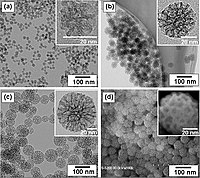
Photo from wikipedia
Nanoparticle synthesis was demonstrated via functionalization-induced self-assembly (FISA) of block copolymers using Suzuki–Miyaura cross-coupling. In situ self-assembly was triggered in organic media by the progressive installation of solvophobic pendant groups… Click to show full abstract
Nanoparticle synthesis was demonstrated via functionalization-induced self-assembly (FISA) of block copolymers using Suzuki–Miyaura cross-coupling. In situ self-assembly was triggered in organic media by the progressive installation of solvophobic pendant groups onto an initially soluble diblock copolymer, rendering the reactive block insoluble and causing the formation of spherical polymeric micelles. Self-assembly was found to depend on the percent functionalization (f%), where after a critical threshold micelles were accessible that increased in size with increasing f% values. We found the chemical nature of the installed functional group to be crucial for conducting FISA and for controlling the solution morphology, with relatively solvophilic adducts remaining as unimers and increasingly solvophobic adducts trending toward larger micelles, from ca. 40 to 100 nm in diameter. The core and corona of the anticipated micellar structure were visualized using fluorine mapping through electron energy loss spe...
Journal Title: ACS Macro Letters
Year Published: 2018
Link to full text (if available)
Share on Social Media: Sign Up to like & get
recommendations!